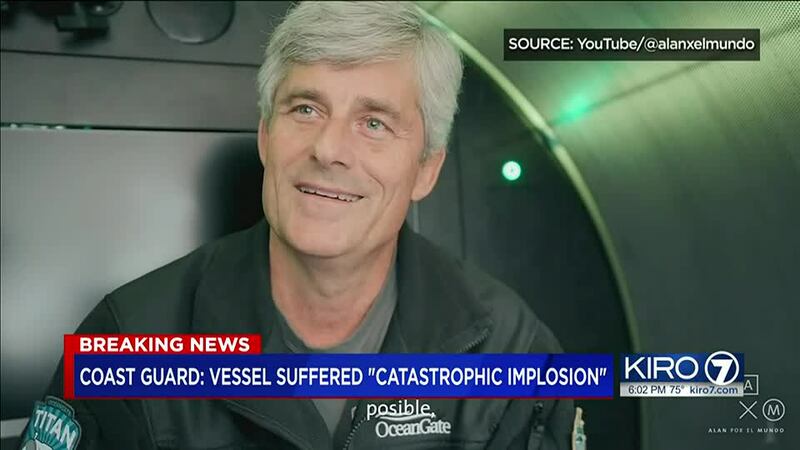A tragic end to the search for the crew on board a missing submersible that disappeared in the Atlantic Ocean four days ago. Investigators said Thursday crews found a debris field – and believe all five men died instantly when the Everett-based sub imploded.
But more troubling questions are cropping up about the company that built the vessel, and CEO Stockton Rush, who perished at the bottom of the ocean.
Rush freely admitted he broke rules when building the sub and said so in an interview with YouTuber Alan Estrada in 2021.
“I’ve broken some rules to make this, I think I’ve broken them with good logic and good engineering behind me. The carbon fiber and titanium, there’s a rule you don’t do that – well I did,” Rush said in the video.
He has also publicly spoken about red tape holding back innovation in an interview with the Smithsonian in 2019. Now he and four others are believed dead. Those who knew him are grieving.
“As we push the boundaries, we learn something. And they pushed the boundaries,” said Bryan Dennis, with Puget Sound Composites. Dennis’ company is two doors down from OceanGate at the Port of Everett shipyard. He said they built some components that were essentially decorative shielding for the sub’s exterior.
“Stockton and his crew, the engineers -- all great people. They were pursuing something that they ultimately gave their lives for,” Dennis said. “We’ll all mourn the loss but we’re proud of them – very proud,” he said.
But some of Rush’s statements about exactly how the sub came together are also raising red flags. As KIRO7 has reported, Rush told CBS in an interview last year that there was no compromise on critical safety elements.
“The pressure vessel is not Macgyver’ed at all because that’s where we worked with Boeing, NASA, and the University of Washington,” Rush said at the time.
But on Thursday, Boeing sent KIRO7 a statement that said: “Boeing was not a partner on the Titan and did not design or build it.”
The University of Washington also said its Applied Physics Lab “was not involved in the design, engineering or testing of the Titan submersible used in the RMS TITANIC expedition.”
UW did work with OceanGate on another shallow-water sub (not deep water) named “Cyclops” that can travel to 500 meters in depth. UW spokesperson Victor Balta said that the collaboration ended early.
“University of Washington’s Applied Physics Laboratory initially signed a $5 million research collaborative agreement with OceanGate, but only $650,000 worth of work was completed before the two organizations parted ways‚” Balta said in a statement. The UW didn’t answer questions on why the partnership ended.
KIRO7 also reached out to NASA. Spokesperson Lance Davis said the Marshall Space Flight Center did consult OceanGate on materials and manufacturing remotely during the pandemic, but did not do any testing, and did not provide any approvals.
Still, people who knew Rush remember him as a true innovator.
“I think Stockton is one of those guys that took us to the next level. And I’m proud of them, and I’m proud of what they did,” Dennis said. “Success isn’t final. Failure isn’t eternal. It’s courage that matters –these guys had courage and they demonstrated that. It motivates me and I’ll keep going,” he said.
As for why the Titan imploded on its way down to visit the Titanic, the Coast Guard said ROVs will stay on the scene to continue mapping the debris field and working to put together answers.
©2023 Cox Media Group








